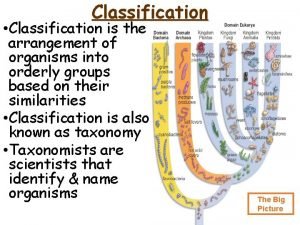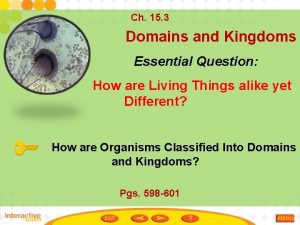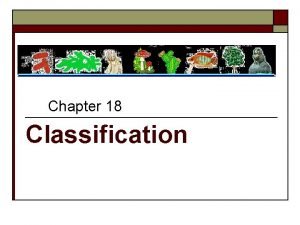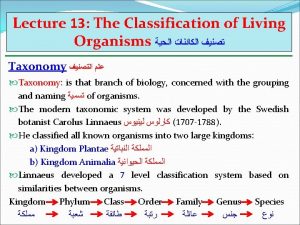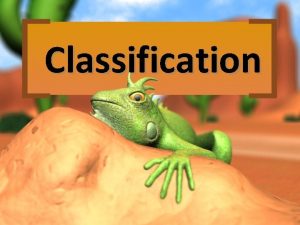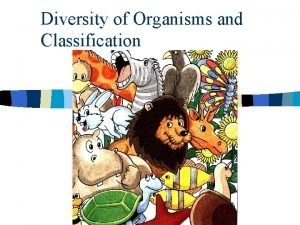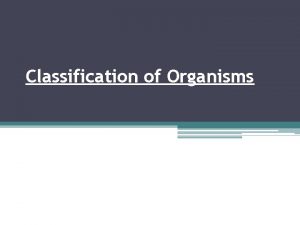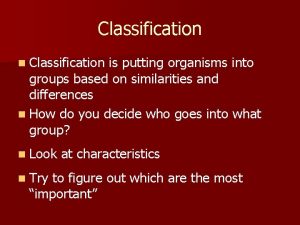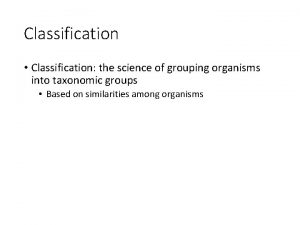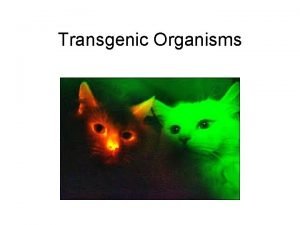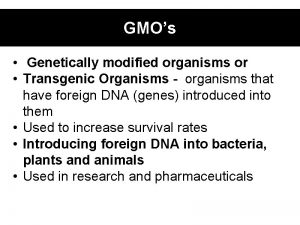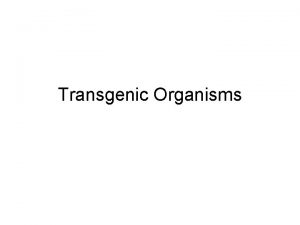Chapter 9 Classification The arrangement of organisms into

































- Slides: 33

Chapter 9 Classification

The arrangement of organisms into orderly groups based on their similarities and presumed evolutionary relationships Click for Term

Classification The arrangement of organisms into orderly groups based on their similarities and presumed evolutionary relationships Click for Term

The most general of the seven levels of classification Click for Term

Kingdom The most general of the seven levels of classification Click for Term

The level of classification after kingdom Click for Term

Phylum The level of classification after kingdom Click for Term

The level of classification after phylum Click for Term

Class The level of classification after phylum Click for Term

The level of classification after class Click for Term

Order The level of classification after class Click for Term

The level of classification after order Click for Term

Family The level of classification after order Click for Term

The level of classification after family Click for Term

Genus The level of classification after family Click for Term

The most specific of the seven levels of classification; characterized by a group of organisms that can mate with one another to produce fertile offspring Click for Term

Species The most specific of the seven levels of classification; characterized by a group of organisms that can mate with one another to produce fertile offspring Click for Term

The science of identifying, classifying and naming living things Click for Term

Taxonomy The science of identifying, classifying and naming living things Click for Term

An aid to identifying unknown organisms that consists of several pairs of descriptive statements; of each pair of statements, only one will apply to the unknown organism, and that will lead to another set of statements, and so on, until the unknown organism can be identified Click for Term

Dichotomous key An aid to identifying unknown organisms that consists of several pairs of descriptive statements; of each pair of statements, only one will apply to the unknown organism, and that will lead to another set of statements, and so on, until the unknown organism can be identified Click for Term

A classification kingdom that contains ancient bacteria that thrive in extreme environments Click for Term

Archaebacteria A classification kingdom that contains ancient bacteria that thrive in extreme environments Click for Term

A classification kingdom containing mostly free-living bacteria found in many varied environments Click for Term

Eubacteria A classification kingdom containing mostly free-living bacteria found in many varied environments Click for Term

A kingdom of eukaryotic single-celled or simple, multicellular organisms; contains all eukaryotes that are not plants, animals or fungi Click for Term

Protista A kingdom of eukaryotic single-celled or simple, multicellular organisms; contains all eukaryotes that are not plants, animals or fungi Click for Term

The kingdom that contains complex multicellular organisms that are usually green and use the sun’s energy to make sugar by photosynthesis Click for Term

Plantae The kingdom that contains complex multicellular organisms that are usually green and use the sun’s energy to make sugar by photosynthesis Click for Term

A kingdom of complex organisms that obtain food by breaking down other substances in their surroundings and absorbing the nutrients Click for Term

Fungi A kingdom of complex organisms that obtain food by breaking down other substances in their surroundings and absorbing the nutrients Click for Term

The classification kingdom containing complex, multicellular organisms that lack cell walls, are usually able to move about, and possess nervous systems that help them be aware of and react to their surroundings Click for Term

Animalia The classification kingdom containing complex, multicellular organisms that lack cell walls, are usually able to move about, and possess nervous systems that help them be aware of and react to their surroundings Click for Term
 The arrangement of organisms into taxa
The arrangement of organisms into taxa Member of the same species
Member of the same species Unicellular and multicellular.
Unicellular and multicellular. Most general to most specific classification
Most general to most specific classification Hibbett classification fungi
Hibbett classification fungi How are organisms classified into domains and kingdoms
How are organisms classified into domains and kingdoms Taxonomy of bacteria
Taxonomy of bacteria The six kingdoms
The six kingdoms When classifying organisms orders are grouped together into
When classifying organisms orders are grouped together into It is the arrangement of something into different groups
It is the arrangement of something into different groups Organisms taxonomy
Organisms taxonomy Prenucleus
Prenucleus Living things table
Living things table Classification arrangement
Classification arrangement Hát kết hợp bộ gõ cơ thể
Hát kết hợp bộ gõ cơ thể Ng-html
Ng-html Bổ thể
Bổ thể Tỉ lệ cơ thể trẻ em
Tỉ lệ cơ thể trẻ em Gấu đi như thế nào
Gấu đi như thế nào Glasgow thang điểm
Glasgow thang điểm Bài hát chúa yêu trần thế alleluia
Bài hát chúa yêu trần thế alleluia Môn thể thao bắt đầu bằng từ đua
Môn thể thao bắt đầu bằng từ đua Thế nào là hệ số cao nhất
Thế nào là hệ số cao nhất Các châu lục và đại dương trên thế giới
Các châu lục và đại dương trên thế giới Cong thức tính động năng
Cong thức tính động năng Trời xanh đây là của chúng ta thể thơ
Trời xanh đây là của chúng ta thể thơ Mật thư tọa độ 5x5
Mật thư tọa độ 5x5 Làm thế nào để 102-1=99
Làm thế nào để 102-1=99 Phản ứng thế ankan
Phản ứng thế ankan Các châu lục và đại dương trên thế giới
Các châu lục và đại dương trên thế giới Thơ thất ngôn tứ tuyệt đường luật
Thơ thất ngôn tứ tuyệt đường luật Quá trình desamine hóa có thể tạo ra
Quá trình desamine hóa có thể tạo ra Một số thể thơ truyền thống
Một số thể thơ truyền thống Cái miệng bé xinh thế chỉ nói điều hay thôi
Cái miệng bé xinh thế chỉ nói điều hay thôi
